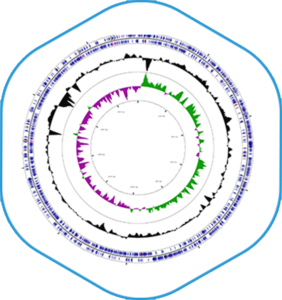B lactis Bi-07™ has been studied alone and frequently alongside NCFM®, Bl-04®, and Lpc-37™ as part of the HOWARU® Restore blend for digestive health.1 It has also been clinically studied in combination with NCFM® for pediatric immune health.2 Extensive in vitro and in vivo studies support the health-enhancing, probiotic properties of B. lactis Bi-07™. The strain has been published in more than 80 scientific publications and in 32 clinical trials that extend from toddlers (7 months of age) to aging populations (70 years of age). Bi-07™ has a long history of safe use, is well suited for intestinal survival, and has strong adhesion to intestinal cell lines. 3-9
BIFIDOBACTERIUM ANIMALIS SSP. LACTIS
Bi-07™
In this section
- Our signature strains
Menu

Bi-07™ introduction
56 In vitro through product functionality studies
+31
Clinical trials
| HEALTH-BENEFIT AREA | SUPPORTED DOSING (CFU) | STUDY REFERENCE |
| Dysbiosis restoration | 17 billion (equal parts) Bi-07™, NCFM®, Bl-04®, Lpc-37™ | Ouwehand AC, et al. Vaccine. 2014;32(4):458-463. |
| Pediatric immune health | 10 billion (equal parts) Bi-07™ and NCFM® | Leyer GJ, et al. Pediatrics. 2009;124(2):e172-179. |
For additional information, visit our Bi-07™ bibliography
REFERENCES:
1. Ouwehand AC, DongLian C, Weijian X, et al. Probiotics reduce symptoms of antibiotic use in a hospital setting: a randomized dose response study. Vaccine. 2014;32:458-463. 2. Leyer GJ, Li S, Mubasher ME, Reifer C, Ouwehand AC. Probiotic effects on cold and influenza-like symptom incidence and duration in children. Pediatrics. 2009;124(2):e172-179. 3. Candela M, Bergmann S, Vici M, et al. Binding of human plasminogen to Bifidobacterium. J Bacteriol. 2007;189:5929-5936. 4. Candela M, Biagi E, Centanni M, et al. Bifidobacterial enolase, a cell surface receptor for human plasminogen involved in the interaction with the host. Microbiology. 2009;155:3294-3303. 5. Candela M, Miccoli G, Bergmann S, et al. Plasminogen dependent proteolytic activity in Bifidobacterium lactis. Microbiology. 2008;154:2457-2462. 6. Candela M, Perna F, Carnevali P, et al. Interaction of probiotic Lactobacillus and Bifidobacterium strains with human intestinal epithelial cells: adhesion properties, competition against enteropathogens and modulation of IL-8 production. Int J Food Microbiol. 2008;125:286-292. 7. Candela M, Fiori J, Dipalo S, et al. Rapid MALDI-TOF-MS analysis in the study of interaction between whole bacterial cells and human target molecules: Binding of Bifidobacterium to human plasminogen. J Microbiol Methods. 2008;73:276–278. 8. Candela M, Seibold G, Vitali B, et al. Real-time PCR quantification of bacterial adhesion to Caco-2 cells: Competition between bifidobacterial and enteropathogens. Res Microbiol. 2005;156:887–895. 9. Candela M, Turroni S, Centanni M, et al. Relevance of Bifidobacterium animalis subsp. lactis plasminogen binding activity in the human gastrointestinal microenvironment. Appl Environ Microbiol. 2011;77:7072-7076.
1. Ouwehand AC, DongLian C, Weijian X, et al. Probiotics reduce symptoms of antibiotic use in a hospital setting: a randomized dose response study. Vaccine. 2014;32:458-463. 2. Leyer GJ, Li S, Mubasher ME, Reifer C, Ouwehand AC. Probiotic effects on cold and influenza-like symptom incidence and duration in children. Pediatrics. 2009;124(2):e172-179. 3. Candela M, Bergmann S, Vici M, et al. Binding of human plasminogen to Bifidobacterium. J Bacteriol. 2007;189:5929-5936. 4. Candela M, Biagi E, Centanni M, et al. Bifidobacterial enolase, a cell surface receptor for human plasminogen involved in the interaction with the host. Microbiology. 2009;155:3294-3303. 5. Candela M, Miccoli G, Bergmann S, et al. Plasminogen dependent proteolytic activity in Bifidobacterium lactis. Microbiology. 2008;154:2457-2462. 6. Candela M, Perna F, Carnevali P, et al. Interaction of probiotic Lactobacillus and Bifidobacterium strains with human intestinal epithelial cells: adhesion properties, competition against enteropathogens and modulation of IL-8 production. Int J Food Microbiol. 2008;125:286-292. 7. Candela M, Fiori J, Dipalo S, et al. Rapid MALDI-TOF-MS analysis in the study of interaction between whole bacterial cells and human target molecules: Binding of Bifidobacterium to human plasminogen. J Microbiol Methods. 2008;73:276–278. 8. Candela M, Seibold G, Vitali B, et al. Real-time PCR quantification of bacterial adhesion to Caco-2 cells: Competition between bifidobacterial and enteropathogens. Res Microbiol. 2005;156:887–895. 9. Candela M, Turroni S, Centanni M, et al. Relevance of Bifidobacterium animalis subsp. lactis plasminogen binding activity in the human gastrointestinal microenvironment. Appl Environ Microbiol. 2011;77:7072-7076.
